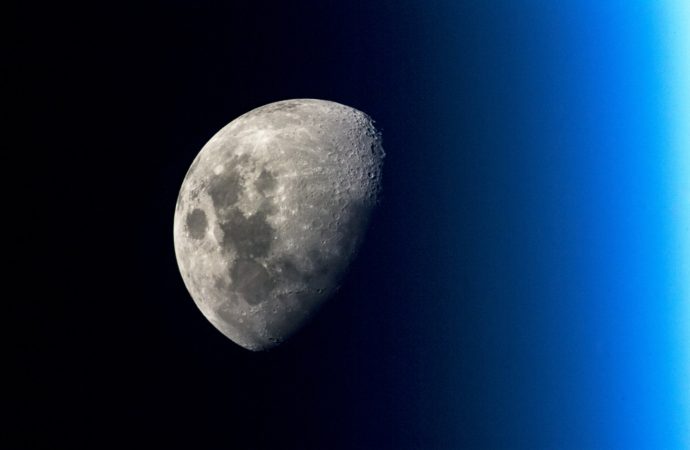The U.S. Geological Survey (USGS) is starting to earnestly evaluate space resources for future mining.
Since its establishment in the 1870s, the USGS has focused pretty much solely on Earth. But now it’s also investigating what benefits may or may not exist in tapping extraterrestrial water, minerals and metals.
The agency seeks to portray accurately how humanity could exploit off-Earth assets — a no-nonsense approach that contrasts with the pie-in-the-sky estimates of trillions of dollars of profit proffered by some less scientifically minded space-mining advocates.

Credit: United Launch Alliance
Proven expertise
This past June, several USGS experts took part in a Space Resources Roundtable held at the Colorado School of Mines in Golden, Colorado.
“The space-resources community will benefit greatly from working together with the USGS to assess the location and value of minerals, energy and water on the moon, Mars and asteroids,” said Angel Abbud-Madrid, director of the Center for Space Resources at the Colorado School of Mines.
The USGS offers proven expertise and an unbiased, quantitative approach to characterizing terrestrial resources, Abbud-Madrid told Space.com. That know-how “can also lead to reliable and much-needed geological maps for more precise landing-site and resource-deposit selection,” he said.
It’s also worth noting that the new director of the USGS, Jim Reilly, is a geoscientist and former NASA astronaut. During his 13-year NASA career, Reilly flew on three space shuttle missions, conducted five spacewalks and racked up a total of more than 856 hours in orbit.

Credit: Joel Sercel/ICS Associates Inc. and TransAstra
Multifaceted issue
The exploitation of space resources is a fascinating and multifaceted issue, said Laszlo Kestay, a research geologist at the USGS Astrogeology Science Center in Flagstaff, Arizona.
“The USGS has been paying steadily increasing attention to the issue of space resources for the last several years,” Kestay told Space.com. The drivers for this are diverse, he said. For example, the U.S. human space program seems to be focusing on missions to deep space, where space resources are extremely valuable. Furthermore, commercial efforts to extract space resources are growing in maturity.
Kestay pointed to the USGS’ increased responsibility for the Landsat satellites, a venerable series of Earth-observing spacecraft. The USGS is now considered one of the U.S. space agencies, he said.
“The USGS realized that our congressional mandate to assess natural resources extends to space,” Kestay said.
At this time, the USGS does not have a funded program to conduct full-scale assessments of space resources. “But we are anticipating that the USGS may be directed to do so soon, and we are taking a number of steps to be prepared for that possibility,” he said.

Credit: TransAstra Corporation & Anthony Longman
Confidence building
Kestay pointed to the USGS’ participation in space-resource workshops. In addition, there’s the 2017 “Feasibility Study for the Quantitative Assessment of Mineral Resources in Asteroids” led by Kestay, which found that the water and metal resources of near-Earth asteroids are sufficient to support humanity should it become a fully spacefaring species.
“At this point, we have done enough work to feel confident that the methods the USGS uses to assess mineral, energy and water resources on Earth can be used to assess space resources with minimal modification,” Kestay said. “We have also done enough preliminary work to identify some areas where humanity’s lack of knowledge will result in exceedingly large uncertainties in assessments undertaken today.”
Follow the water
“Lunar ice would be a good example of a resource that we do not understand well enough to provide estimates with much precision,” Kestay said.
Attempting such an assessment could still be “useful,” he said, because it can identify the most critical information that future missions need to collect.
“It is also perhaps counterintuitive that we have a much better understanding of ice on Mars than on our own moon, but NASA’s ‘follow the water’ strategy [on the Red Planet] has provided a wealth of knowledge,” Kestay said. “Finally, it is clear, even before we undertake a full-blown assessment, that there are significant resources in space to assess!”
“Given the even higher costs of space travel and development, new space resource models and assessment techniques are a prerequisite for practical development of space resources,” Meinert said.
Lessons learned from terrestrial exploration, mining and assessment can be applied to space resources, Meinert said. “So it’s not just the excitement of new knowledge; there are certain things you need to do. One of them is characterizing what it is you’re going to develop,” he told Space.com.
Policy, investment decision making
Space-resource assessments will require a combination of remote sensing and physical sampling to better constrain actual asteroid, moon and planetary compositions, at a scale appropriate for resource classification and potential utilization, Meinert said.
“This information can then be used to inform resource-assessment models that have been developed and successfully utilized on Earth,” Meinert concluded. “Such model assessments will be foundational to guide policy and investment decisions concerning the emerging field of space resources.”
Source: Space.com

































Leave a Comment
You must be logged in to post a comment.